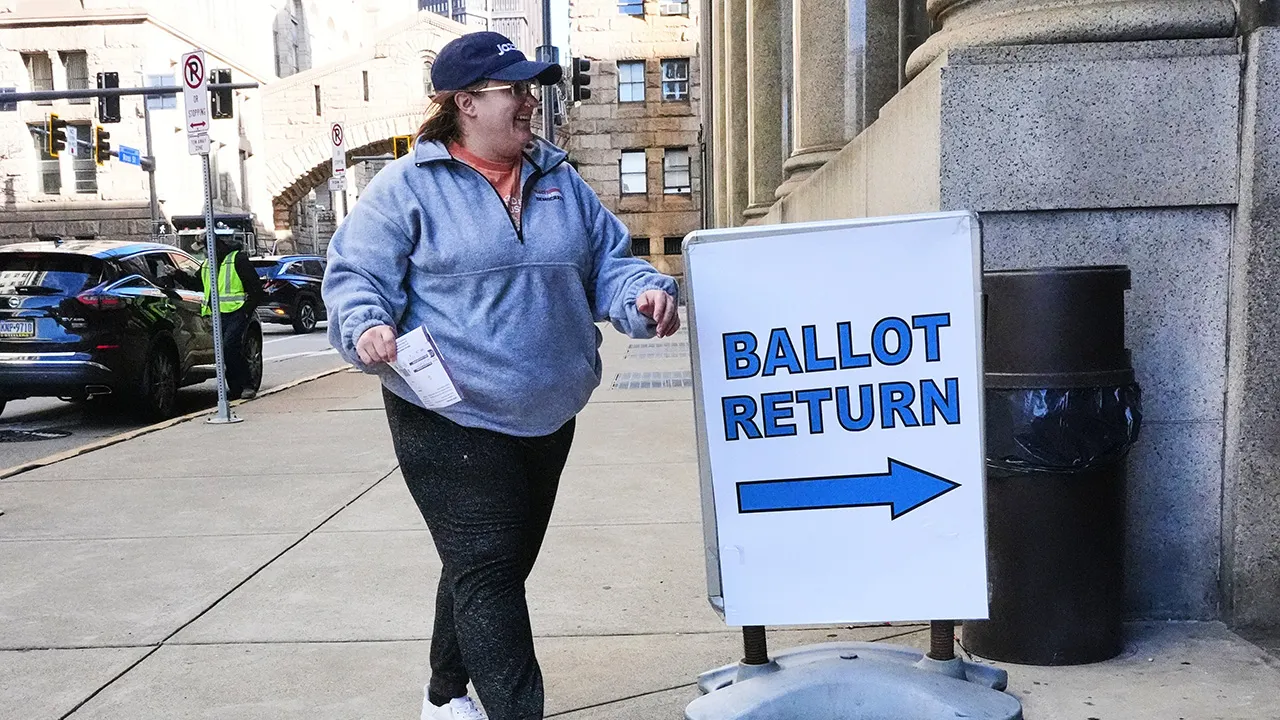Vermont
Vermont Ave. bus priority lanes could start work in March
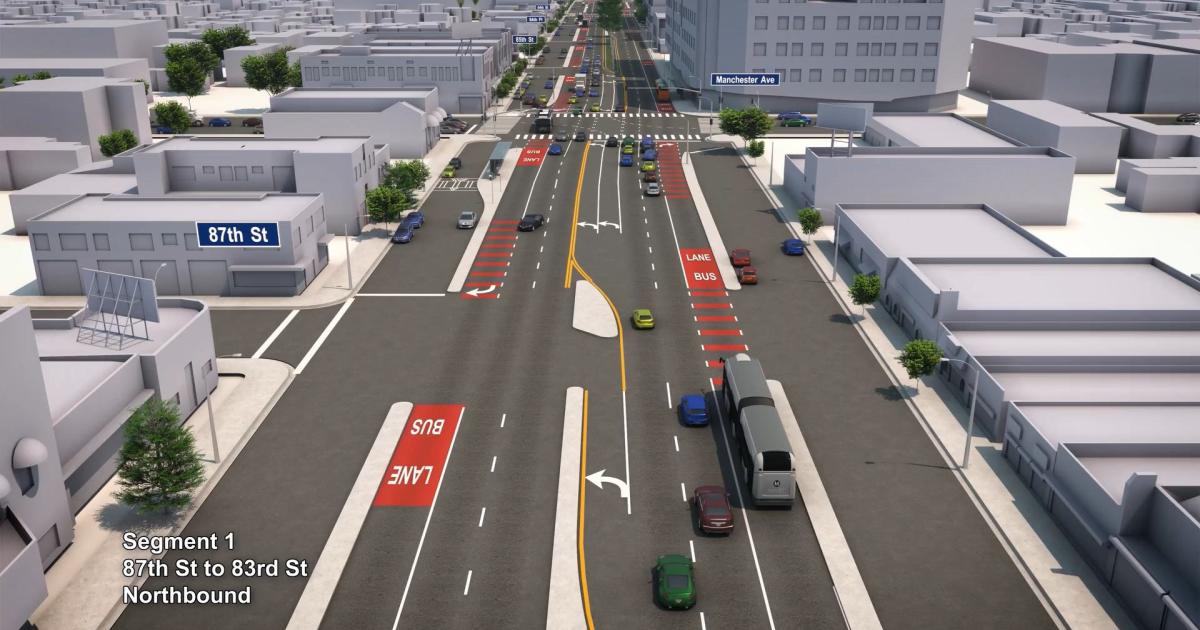
Work is set to begin as early as March 2025 for near-term improvements that will set the stage for a bus rapid transit line down Vermont Avenue, Metro announced this week.
The Vermont Transit Corridor, which runs roughly 12 miles of Vermont Avenue between Hollywood Boulevard in Los Feliz and 120th Street in unincorporated Athens, sees approximately 36,000 transit trips on a daily basis. That makes it the busiest bus route in Metro’s network.
Rendering of Vermont BRT segment from 4th Street to 1st Street looking northMetro
Plans to upgrade the corridor with bus rapid transit infrastructure date to 2016, when Los Angeles County voters approved funding for the project via the Measure M sales tax. The final design for the project, which has been labeled “underwhelming,” calls for eventually implementing end-to-end side running bus lanes along the full corridor for use by Metro and local bus lines.
However, that plan remains several years away from fruition. In the meantime, the Los Angeles Department of Transportation will start early work on the project by converting peak-hour tow-away lanes on Vermont between Sunset and Wilshire Boulevards into bus priority lanes. That process is slated to take approximately six months to complete.
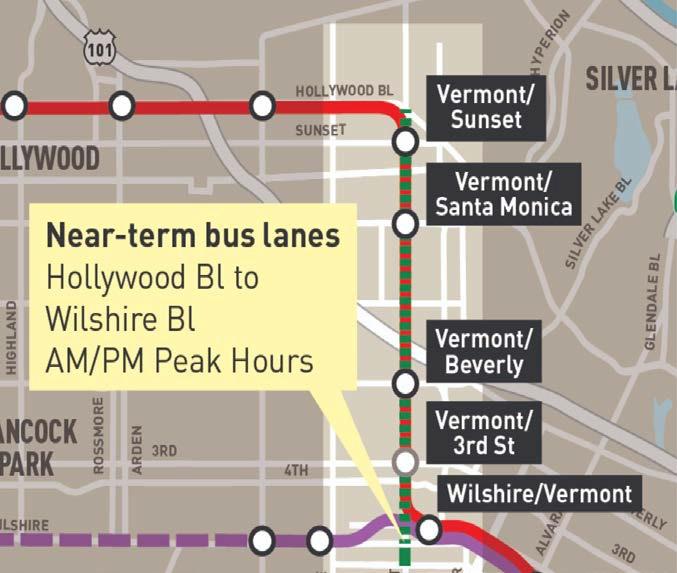
Northern bus lane segmentMetro
Construction will occur on weekdays from 9 am to 3 pm and 7 pm to 7 am, then on Saturdays from 8 am to 6 pm. The new bus lanes will also extend or change the hours of parking restrictions on Vermont as follows:
- The existing 4:00 – 7:00 PM weekday parking restrictions on Vermont Avenue (between Sunset and Wilshire) will shift to 3:00 – 7:00 PM.
- Areas currently restricted from 7:00 – 9:00 AM on weekdays will be extended to 7:00 – 10:00 AM.
- Locations without existing morning restrictions will have new 7:00 – 10:00 AM weekday parking limits.
Separately, additional peak-hour bus lanes will be implemented on the stretch of Vermont between Gage Street in South Los Angeles and the Vermont/Athens C Line Station within the median of the I-105 Freeway. The full BRT project would connect those two segments by 2028 in advance of the Olympics.
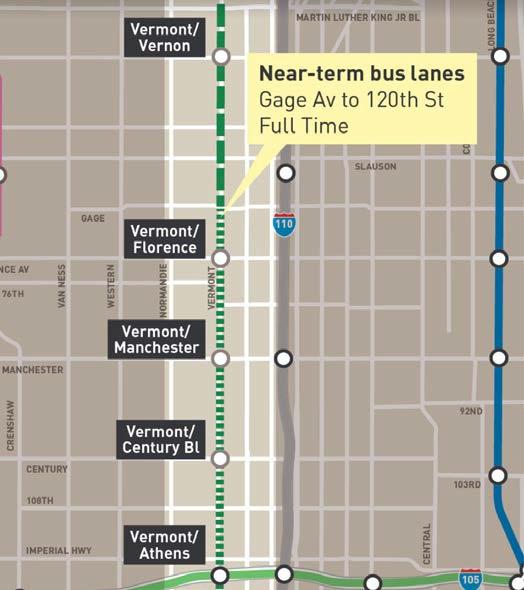
Southern bus lane segmentMetro
Metro expects the dedicated lanes will increase ridership on Vermont to 66,000 daily passengers, more than 12,000 of whom would be new daily riders to Metro’s system. Additionally, the project would cut bus travel times from 70 minutes to 53 minutes.
Those high ridership numbers might suggest rail instead of bus. Metro has also looked to the horizon with plans for a subway or light rail line on the corridor, carrying as many as 144,000 daily passengers. However, funding for such an undertaking would not be available until 2067.
Follow us on social media:
Twitter / Facebook / LinkedIn / Threads / Instagram / Bluesky

Vermont
The Supreme Court hears challenges to Trump’s tariffs with Vermont ties – VTDigger

This story is based on stories by Violet Jira published on Nov. 5, 2025 by NOTUS, one before and one after the oral arguments.
The U.S. Supreme Court heard arguments Wednesday related to the legality of President Donald Trump’s use of tariffs in a case that won’t just be deciding the fate of his trade policy, but also could redefine the limits of presidential economic power.
The hearing involved appeals in a pair of cases that challenge the Trump administration’s use of the International Emergency Economic Powers Act, including one with Vermont ties. Trump has used the law to bypass procedural norms and place extensive tariffs on enemies and trading partners alike without authorization from Congress.
READ MORE

One of the cases includes Terry Precision Cycling, or Terry Cycling, a women’s cycling apparel company, as one of five small business plaintiffs. The group sued Trump and his administration in the U.S. Court of International Trade in April. In May, a panel of three federal judges struck down most of the president’s tariffs. The U.S. Court of Appeals for the Federal Circuit also largely backed the plaintiffs. The case was combined with another brought by private organizations impacted by the tariffs in Wednesday’s arguments in the Supreme Court.
The court also heard from a representative of 12 attorneys general, including Vermont Attorney General Charity Clark, who sued on similar grounds.
During the arguments, Solicitor General D. John Sauer defended the Trump administration’s actions — sometimes by contradicting the president.
Sauer faced a slew of skeptical inquiries from the justices who seemed to take issue with many of the Trump administration’s arguments, including that the president has broad authority to respond to international emergencies, Congress delegated the presidency this power, and tariffs are not taxes.
Since the Constitution gives Congress the power to tax, the claim that tariffs are not a tax was central to Sauer’s argument, despite the fact that the president has framed them as revenue-raising.
“We don’t contend that what’s being exercised here is the power to tax,” Sauer said. “It’s the power to regulate foreign commerce. These are regulatory tariffs. They are not revenue raising tariffs.”
Trump regularly says tariffs are making the country richer. And earlier this year, the White House floated using tariffs as a revenue raiser to offset the cost of the One Big Beautiful Bill Act.
Justice Sonia Sotomayor, who spoke recently at the University of Vermont, made clear that she didn’t buy Sauer’s argument on tariffs versus taxes.
“You say tariffs are not taxes, but that’s exactly what they are,” she said. “They’re generating money from American citizens, revenue.”

‘Simply implausible’
How the justices decide the case will have major implications not just for Trump’s agenda but for how much unilateral power presidents have to regulate commerce.
During the arguments, Justice Neil Gorsuch leaned heavily into the question of congressional authority. He seemed to take issue with the fact that it would be difficult for Congress to reclaim that authority should the Supreme Court give the Trump administration what it was asking for.
“Congress, as a practical matter, can’t get this power back once it’s handed it over to the president. It’s a one way ratchet toward the gradual but continual accretion of power in the executive branch and away from the people’s elected representatives,” he argued.
Justice Amy Coney Barrett seemed skeptical of the scope of the reciprocal tariffs Trump has placed on dozens of countries, allies and trading partners alike.
“Is it your contention that every country needed to be tariffed because of threats to the defense and industrial base? I mean, Spain, France? I mean, I could see it with some countries, but explain to me why as many countries needed to be subject to the reciprocal tariff policy as are,” she asked.
The small businesses were represented by attorney Neal Katyal. He argued that tariffs are, in fact, a tax, and that the Trump administration was exceeding the authority Congress intended to give to the executive branch when it passed the International Emergency Economic Powers Act.
“It’s simply implausible that in enacting IEEPA, Congress handed the president the power to overhaul the entire tariff system and the American economy in the process, allowing him to set and reset tariffs on any and every product from any and every country at any and all times,” Katyal said.
“And as Justices Gorsuch and Barrett just said, this is a one-way ratchet,” he continued. “We will never get this power back if the government wins this case. What president wouldn’t veto legislation to rein this power in and pull out the tariff power?”
The Supreme Court has until the end of its term next summer to make a decision, but the case has so far been on an expedited track, leading some experienced court watchers to expect a decision before the end of the year.
Other routes for tariffs
The White House has projected confidence in its ability to win the case — press secretary Karoline Leavitt said officials believe the Supreme Court will rule in their favor. Still, contingency plans have long been in the works.
“The White House is always preparing for plan B,” she said at a briefing. “It would be imprudent of the president’s advisers not to prepare for such a situation. With that said, we are 100% confident in the president and his team’s legal argument and the merits of the law in this case, and we remain optimistic that the Supreme Court is going to do the right thing. The importance of this case cannot be overstated.”
Trump has used the threat of tariffs in matters far beyond trade. The administration used a tariff investigation to pressure Brazil over its decision to prosecute former President Jair Bolsonaro. Trump attempted to use trade negotiations to stop Canada from backing Palestinian statehood. The threat of steep tariffs has been an essential leverage point in his peace negotiations between countries like India and Pakistan, as well as Russia and Ukraine.
The Supreme Court’s decision could stymie all of this.
Administration officials have indicated that even if they lose the case, they would find another way to levy tariffs.
There are multiple legal avenues to enact tariffs. Top Trump trade adviser Peter Navarro has signaled the administration was considering use of Section 122 and then Section 301 of the Trade Act of 1974, if use of the International Emergency Economic Powers Act is deemed unlawful.
Multiple trade experts NOTUS spoke to said this would be the most plausible course of action for Trump to keep his tariffs alive if the court rules against him.
Peter Harrell, who served as senior director for international economics and competitiveness in the Biden White House, said “the most obvious choice” for the White House to temporarily maintain tariffs would be to invoke Section 122. That would allow tariffs of up to 15% for as long as 150 days on countries whose trade with the U.S. is unjustifiably imbalanced.
“That, to me, looks like the sort of obvious, immediate stop gap they could pull to keep many of their tariffs in place for a couple of months while they figure out what the longer term plan is,” he said.
Section 301 of the trade act allows an administration to launch investigations into specific countries and implement tariffs based on the results of that investigation. There are already active Section 301 investigations into China, Brazil and Nicaragua; the latter two were started under the administration of President Joe Biden. The Trump administration could begin more of them, but the investigations take months and again open the administration up to the possibility of lawsuits.
Over the past few months, the Trump administration has expanded its use of Section 232 of the Trade Expansion Act of 1962, which allows him to put restrictions on the import of certain goods if they are found after an investigation to threaten national security.
But none of these powers is as expansive as the International Economic Emergency Powers Act, which the Trump administration has used to enact crushing tariffs with the stroke of a pen.
The International Economic Emergency Powers Act “only requires a finding of a national emergency, which is a more unilateral power within the president to make that determination,” said Everett Eissenstat, a partner at Squire Patton Boggs who represented the Trump administration on international trade matters as deputy director of the National Economic Council during Trump’s first term. “There’s no investigation, there’s no congressional consultation, it’s just a declaration of emergency, and that unleashes the power to regulate commerce, regulate importation.”
He added that there “were certainly more limitations” on Section 301 and Section 232.
If the Supreme Court were to rule in the Trump administration’s favor, it’s possible that the ruling wouldn’t just give the administration the legal go-ahead on current tariff policy, but open the door for the International Economic Emergency Powers Act to be used even more broadly than Trump is currently using it.
For the importers, business owners, consumers and taxpayers who are impacted by the president’s trade and tariff policy, a decision from the Supreme Court in either direction is unlikely to offer significant relief from the pressures of the Trump tariff economy.
“Unfortunately, if you’re a business, you can celebrate a Supreme Court win if that’s the way it goes, but you’re not going to be off the hook,” Riley said. “Trump will continue to impose tariffs, continue to impose costs on Americans, but he just won’t have the unlimited authority that he’ll have if the Supreme Court allows the IEEPA tariffs to remain in place.”
Vermont
Tracking Vermont’s 2025 election day results

BARRE, Vt. (WCAX) – Voters hit the polls across the country on Tuesday, weighing in on everything from high-stakes political races to municipal funding.
In Vermont, towns looked to their residents to approve a myriad of projects.
Across the state, Vermont voters considered ballot items pertaining to flood mitigation, infrastructure projects, and a new career center.
After a full workday and an evening of volunteering at the Barre Community Justice Center, Becky Wigg took to the polls.
“I moved here five years ago during the pandemic and really found my community,” said Wigg.
She voted yes to Barre’s $2.4 million flood-resilient housing project and the $3.3 million new public works building, which will be built out of the flood plain.
“I voted yes for the bonds because I believe in Barre. I want to live in a thriving community where everyone has a safe place to live, an affordable place to live, and we have the public services and resources that we need,” said Wigg.
Barre’s unofficial election results show both ballot items were approved.
“Really transformational projects, these are generational things that we’ve been trying to solve, and I’m very, very pleased that the voters showed their confidence in these projects and approved them,” said Barre City Manager Nicolas Storellicastro.
The Hinesburg Record reports that bond issues of repairing two flood-damaged bridges and installing a new well were approved.
Brighton approved their $9.6 million bond to upgrade the town’s wastewater system. Cabot approved spending a quarter million dollars on flood mitigation.
Plainfield’s request to borrow $600,000 as part of a $9 million project to build 40 new homes failed.
And so did Berlin’s bond to form a four-season rec center, as reported by the Times Argus.
Also on central Vermonters’ ballots was the option to build a $149 million new technical education center.
Central Vermont will need to pool results from different towns to find out if the career center will happen. They expect the results on that to come out on Thursday.
Copyright 2025 WCAX. All rights reserved.
Vermont
Vermont knocks off Western New England 75-68
-

 Milwaukee, WI1 week ago
Milwaukee, WI1 week agoLongtime anchor Shannon Sims is leaving Milwaukee’s WTMJ-TV (Channel 4)
-

 News1 week ago
News1 week agoWith food stamps set to dry up Nov. 1, SNAP recipients say they fear what’s next
-

 Culture1 week ago
Culture1 week agoVideo: Dissecting Three Stephen King Adaptations
-

 Seattle, WA4 days ago
Seattle, WA4 days agoESPN scoop adds another intriguing name to Seahawks chatter before NFL trade deadline
-

 Seattle, WA1 week ago
Seattle, WA1 week agoFOX 13’s Aaron Levine wins back-to-back Jeopardy! episodes
-

 San Diego, CA1 week ago
San Diego, CA1 week agoAdd Nick Hundley, Ruben Niebla to list of Padres’ managerial finalists
-
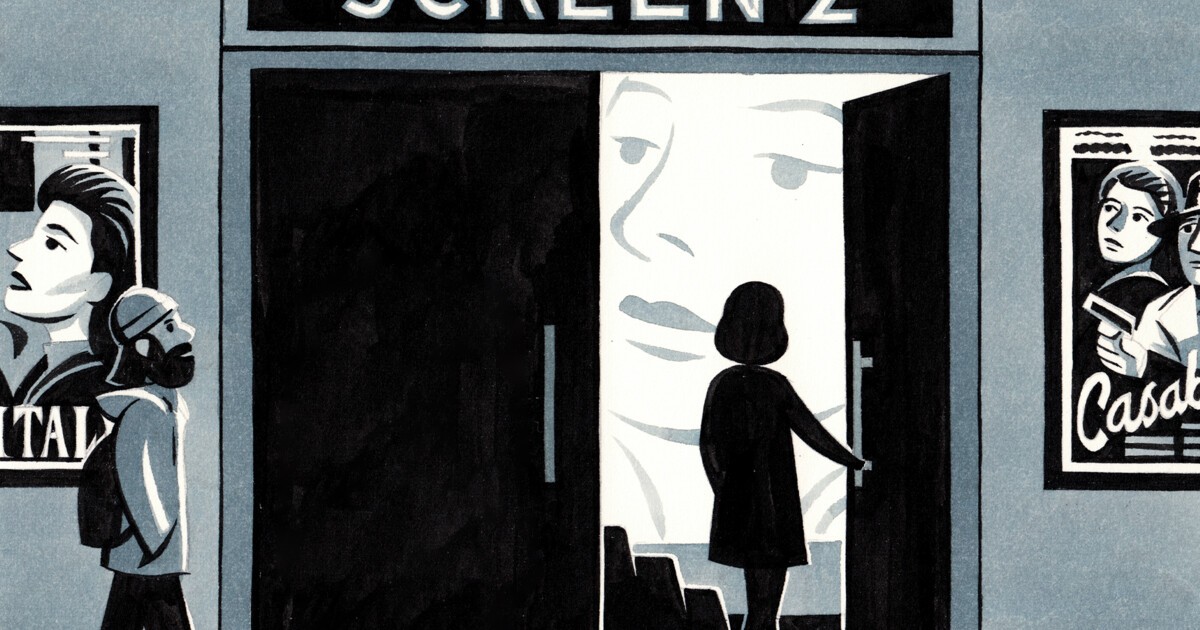
 Movie Reviews1 week ago
Movie Reviews1 week agoLeo Robson · Diary: What I Saw at the Movies
-

 Business6 days ago
Business6 days agoCommentary: Meme stocks are still with us, offering new temptations for novice and unwary investors














